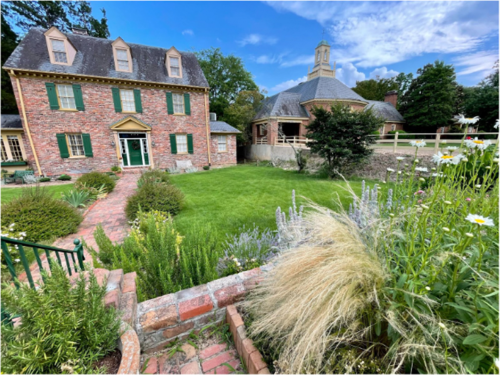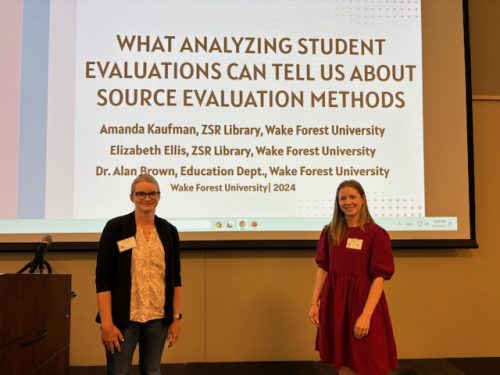The Innovative Library Classroom 2024
On June 6-7, the Innovative Library Classroom (TILC) conference celebrated its 10th annual conference this year, and the 100 available seats filled up in four hours this year! In her opening remarks, Candice Benjes-Small from William & Mary, who leads the steering committee, referred to this small and mighty conference as “Lil’ LOEX!” The theme for this year was “Finite Means, Infinite Uses,” and four librarians from ZSR were presenters! What follows are thoughts and takeaways from the ZSR folks:
Elizabeth Ellis
This was my first time attending TILC but it certainly won’t be my last! I struggle to learn and socialize when I’m hungry, and this conference had abundant snacks which I greatly appreciated! From our lodgings, we could walk to the conference, downtown Williamsburg, and along some beautiful hiking trails that wove through the William & Mary campus. I understand that nothing I’ve commented on so far has anything to do with professional development, but I really value a conference designed with attendees in mind! 
Amanda, Morgan, and I attended the pre-conference workshop called “Words without thoughts: Generative AI, critical thinking, and information literacy.” It was an interesting exploration of how GAI works, some of the major deficits it has in terms of accuracy and contextualizing information requests, and how librarians can use it during instruction on some of the more tedious, mechanical search tasks students struggle with and free up time for other important lessons like source evaluation. Speaking of source evaluation, the presenters shared a GAI Hallucination Leaderboard that may be useful to share with students when teaching these tools, and also asked how ChatGPT would perform on two common evaluation methods– CRAAP and SIFT (which Amanda and I happened to present on– see below). Spoiler: it’s not great, but novice researchers are easily fooled by GAI’s “veneer of authority.”
Amanda Kaufman
This year’s TILC Conference emphasized the evolving role that artificial intelligence will play in library instruction. Things are changing quickly, so I am grateful for the work our colleagues have done to distill down the best of the best from the “nice-to-knows” category. I got a lot out of the “Framing Information Literacy Through A.I.” session, which gave activity, assignment, and AI tool ideas for each of the six frames of the ACRL Framework. I plan on integrating some of those ideas into my LIB100’s this fall.
Of course, I spent the vast majority of my time at TILC preparing for, delivering, and recovering (ha) from presenting with Elizabeth. We shared our research on the SIFT Method. If you are curious, read more about it here

Rebecca May
A session I want to highlight from my first trip to TILC is “Repurposing, Reusing, and Reflecting: Utilizing Information Literacy, Instruction Strategies to Revise Student Worker Training” presented by Cori Biddle of Penn State Altoona. I found this session very helpful in planning for student employee training in Special Collections & Archives. Cori is using LibWizard (from the SpringShare suite of products) to create training modules and quizzes to help train student employees on reference policies and procedures. By assigning students these trainings and quizzes, and then following up with them on in person reference checklists, this pilot program at Penn State Altoona took some of the repetitive work off of the supervisors, and put the learning onto the employees themselves. What I really loved about this is the idea of creating refresher courses for students when they return to work after a summer or semester break. Reinforcing what they need to know about the job would be so much easier if laid out in an instruction type setting. I was excited about putting training into an instructional framework and enjoyed this session greatly.
Morgan Ritchie-Baum
This was my second TILC experience and it did not disappoint. I really enjoy the curated, intimate nature of the sessions plus I got to hang out with six of my ZSR colleagues! I wanted to highlight the session by Towson University’s Science, Technology, and Mathematics Librarian Elizabeth White titled “Which Source is Best? A Source Evaluation Activity for Any Discipline” [https://tinyurl.com/TILC-whichsource]. This session described a source evaluation activity that has students evaluate a variety of source types and then have students choose and reflect on which sources are most appropriate for various personal, academic, and professional contexts. I loved the presentation and the activity for a few different reasons:
- I could seriously see this activity working in any discipline. As a subject librarian in a professional school, I feel like we have to be “sneaky” about how we discuss/introduce info lit topics. It can be hard for the students to connect with/understand what information literacy has to do with creating a SWOT analysis for a specific company or marketing scheme. I could see providing an industry report, blog post by a consulting firm, and financial report to students and having them discuss which source (or combination of sources!) helps inform them best when it comes to creating a SWOT analysis, for example.
- The last time I taught LIB 230, my students really struggled with identifying source type and format. I think an exercise like this could really help students get comfortable with talking about and referencing sources by source type (trade, scholarly, popular, etc.) and format (article, blog, book, etc.) and then connecting with scenarios that make seeking out and/or utilizing those source types and formats the most logical.
- This exercise would work in a lot of different classrooms. I could see coming into a one-shot with several examples of sources and scenarios relevant to the subject/topic/project, breaking the class into groups and having them pick the best source for the specific scenario or vice-versa. In a scenario where you can give preparatory work, use a jigsaw [https://www.kent.edu/ctl/jigsaw] to have students select specific sources they become “experts” on for homework and share their expertise during an in-class exercise.
This session highlights what I love about TILC, practitioners sharing their lived experiences and lessons learned that colleagues in the profession can easily and quickly implement in their own practice. I’m already looking forward to TILC in 2025!
Kathy Shields
TILC is one of my favorite conferences because of the size and the fantastic people! Rebecca and I had a great time presenting at the poster session. In our poster, “Reconsidering the Past to Bring it into the Future: Iterative Teaching with Primary Sources,” we shared how we have redesigned LIB 265 over the past 3 years. There are always so many people who are impressed that we have such a robust credit-bearing instruction program at ZSR! We had lots of good questions and discussions with colleagues from all over about both teaching with primary sources and the pedagogical aspects of our course.
As far as the other sessions, I really enjoyed the presentation from Jessica Ramey & Paul Showalter at William & Mary called “Something Borrowed, Something New.” They shared how they each applied constructivist learning to create activities for classes at the 200 & 300-levels. These can be challenging because the combination of students in those courses is all over the place. How do you engage upper level students who have “heard it all before” while also making sure no one gets left behind? Their solution was to have students work in small-groups to develop their own research plan. Jessica added a creative element by having students create visual representation of their research plan, using fun markers and pens, stickers, etc. to facilitate creativity. In both cases, though, students used the same prompts and tried to capture as many aspects of their process as possible. This activity took most of the class period, with 20 minutes to create the plan, 15-20 minutes to share out and address gaps. I felt this was a really fun way to have students engage in a crucial part of the research process that they would otherwise often skip! I would like to do something like this in LIB 210 the next time I teach it in person! I am also thinking about how I could adapt it for research sessions.
Meghan Webb
Another wonderful TILC conference in the books! Here are some of my highlights:
- David X. Lemmons, Instruction Coordinator for George Mason University Libraries presented an inspiring keynote: “Practice Makes Progress: Finding Your Authentic Voice in the Library Classroom”, highlighting the importance of authenticity and connection in the classroom and offering some practical approaches to cultivating authenticity within instruction. He also suggested ways to develop a reflective practice to help guide teaching experiences.
- Morgan Pruitt from Central Carolina Community College presented “Better Humans, Not Just Better Instruction: Using Social-Emotional Learning to Re- Envision the Purpose of Library Instruction”, exploring the ways in which social-emotional learning (more on CASEL SEL framework) positively contributes to the effectiveness of library instruction and the development of students and librarians. This session paired nicely with the keynote, with further emphasis on relationship-building and connection in the classroom.
- There was A LOT of emphasis on AI at TILC. I didn’t attend every AI-themed session, but I found Jesika Brooks’ (Columbia College) session “Framing Information Literacy Through A.I.” to be particularly interesting and useful. A lot of wonderful, concrete ideas for exploring A.I. through the lens of the ACRL Framework (highlighting different A.I. tools or processes for each frame). I’ll certainly be incorporating some of these ideas and examples in future instruction opportunities.
- And kudos to my colleagues for their awesome presentations! Kathy and Rebecca (Reconsidering the Past to Bring it into the Future: Iterative Teaching with Primary Sources) and Amanda & Elizabeth (What Analyzing Student Evaluations Can Tell Us About Source Evaluation Methods)!
Hu Womack
TILC is such an amazing one-day conference with a very selective process for presenting, so I want to draw attention to the awesome poster Rebecca and Kathy presented titled “Reconsidering the Past to Bring it into the Future: Iterative Teaching with Primary Sources” outlining the development of a 1.5 credit course on archives and primary sources. I also want to mention the excellent presentation by Amanda and Elizabeth titled “What Analyzing Student Evaluations Can Tell Us About Source Evaluation Methods.” The audience appreciated their insights and the opportunity to learn about their research and the results from the data collected! I chose to attend several sessions that focused on AI, and at each session, I was grateful for all the work ZSR librarians like Denice, Elizabeth, and our colleagues in CAT have done to keep us well-informed on generative AI and AI issues in Higher Education. Every time I attend this conference, I return to ZSR with wonderful ideas for teaching and outreach!







5 Comments on ‘ZSR at TILC 2024’
Fantastic post, everyone! Thanks for taking the time to share your TILC experience with us. Elizabeth and Amanda, thanks for sharing your presentation slides about your research findings! Rebecca and Kathy, cheers to your outstanding teaching with primary sources! It is a privilege to work with this esteemed group.
I love the conference theme, that’s very applicable to so much in librarianship. Thank you all for sharing what you’re bringing back, so we all learn and grow and generate! with or without AI 🙂
Great summaries, all!
Thanks for giving us these highlights of TILC! What terrific sessions. Congratulations to the presenters, too! I’m always so happy when some of ZSRs innovations get shared out with others to forward the profession.
Glad to see such a strong showing at TILC. Congrats to all to presented!